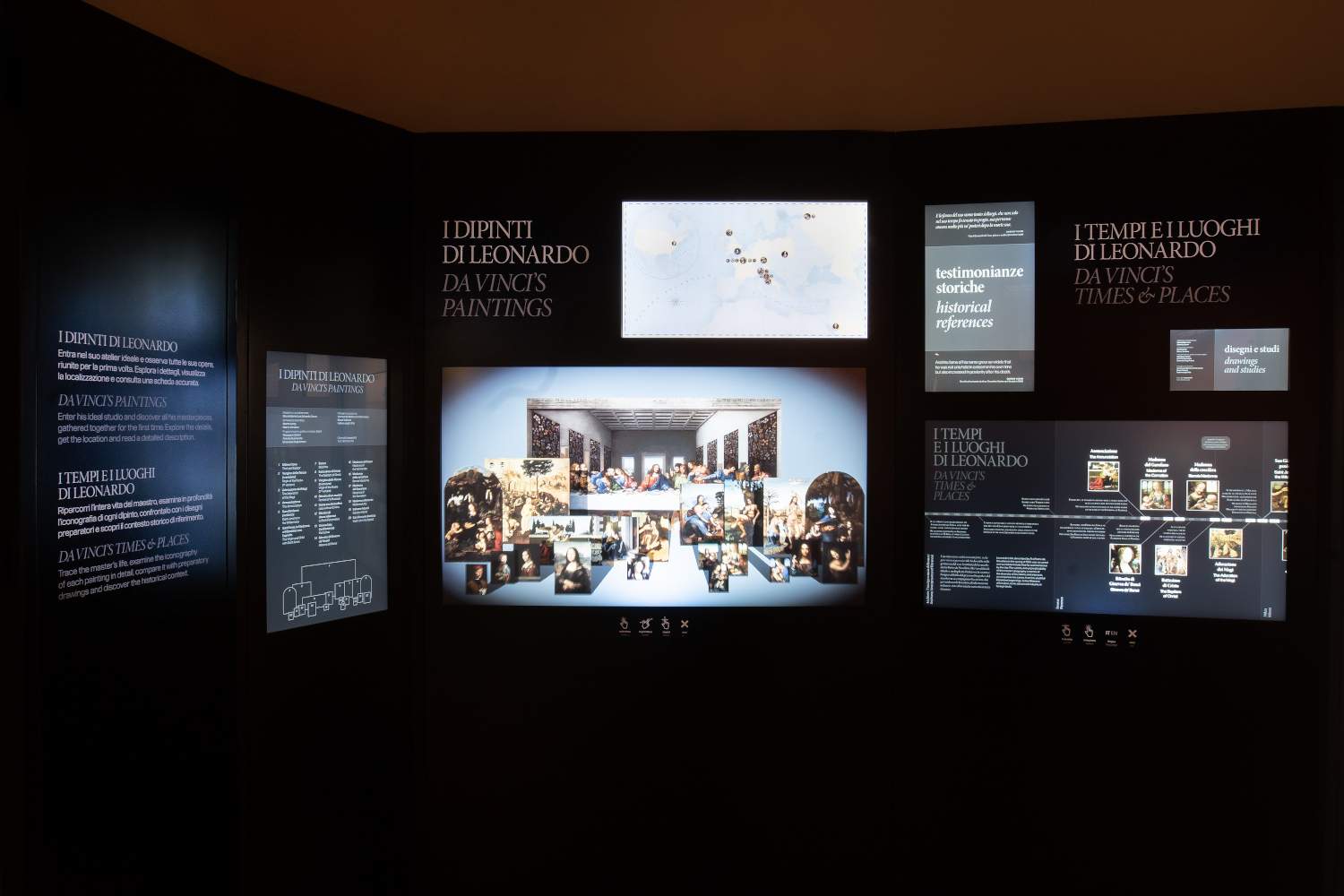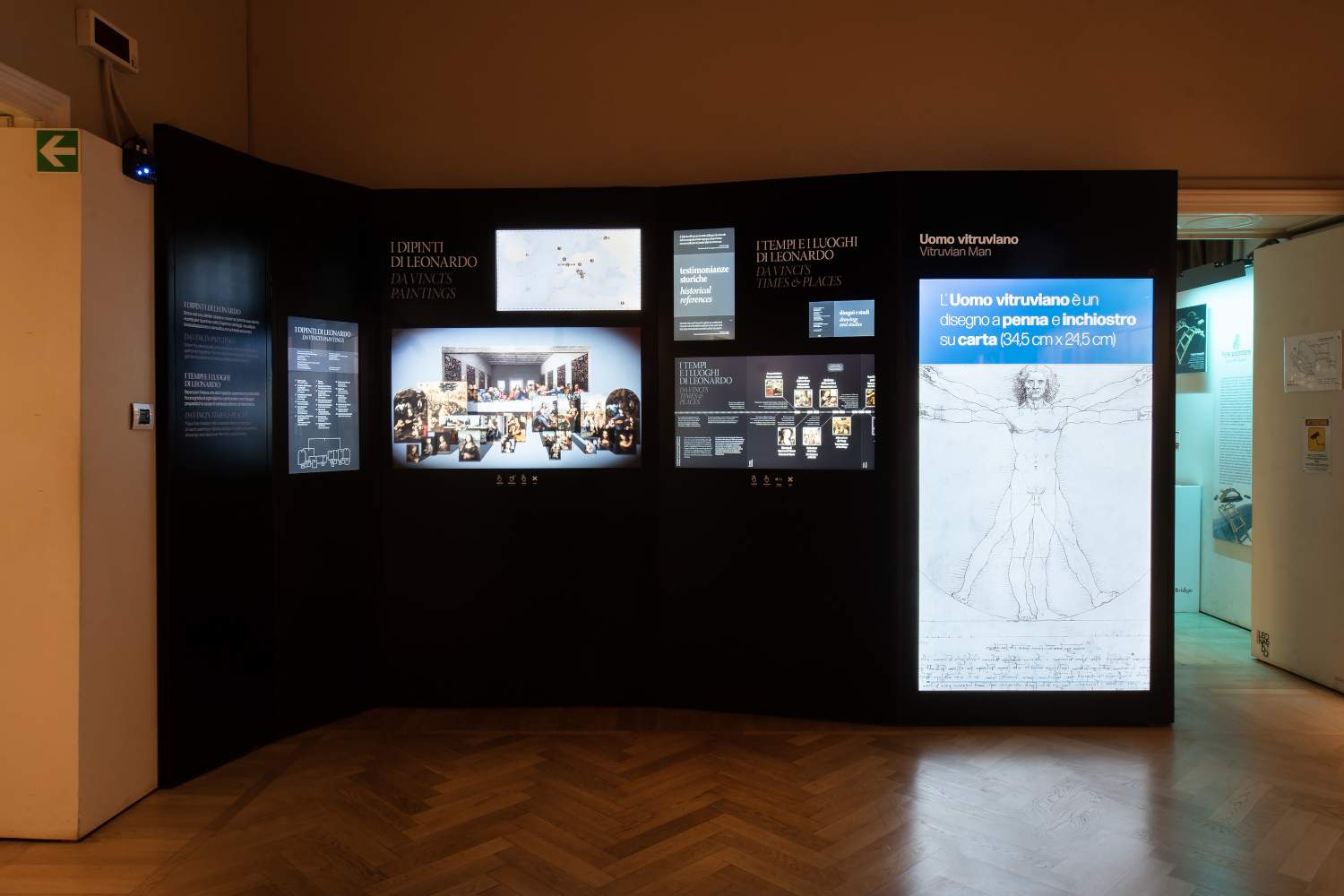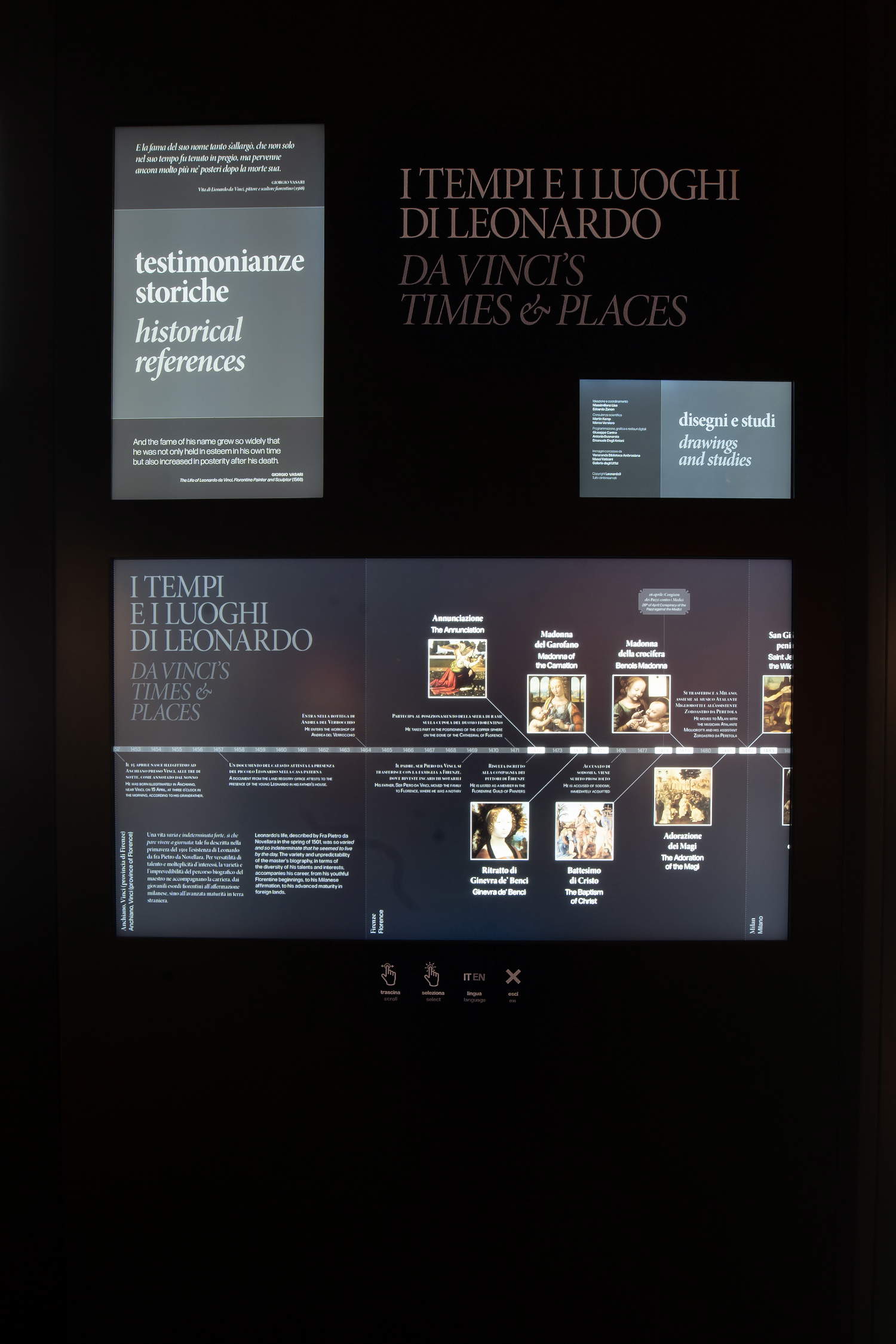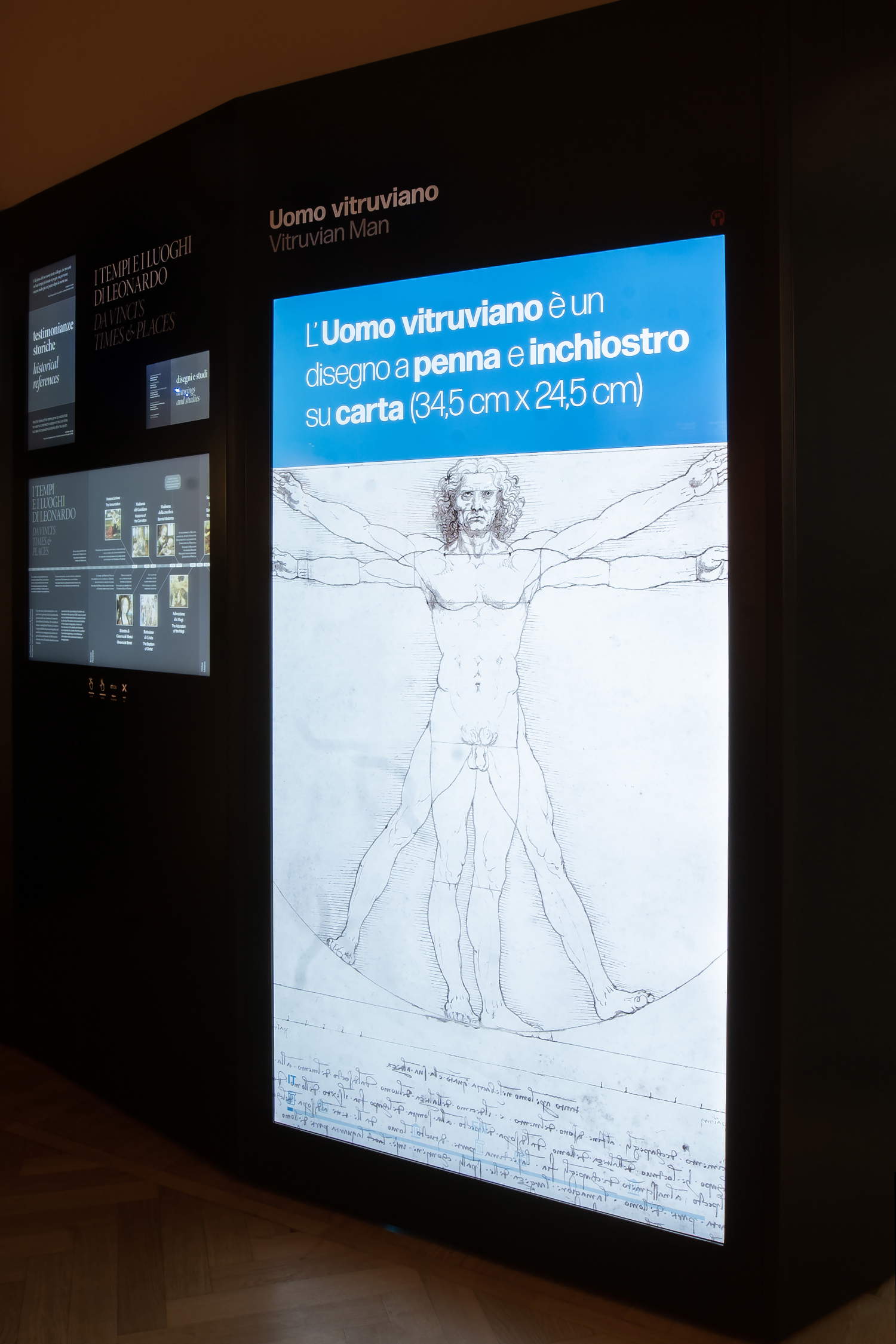At Leonardo3 museum, a new and unprecedented interactive wall brings together twenty paintings by Leonardo da Vinci
The Leonardo3 museum in Milan ’s Piazza della Scala now offers the public a new interactive and multimedia experience: it is The Paintings of Leonardo, an entire interactive wall developed in its entirety by the L3 study center. “Our research center has been studying the work of Leonardo da Vinci for 20 years. This allows us, working only on Leonardo da Vinci, to do absolutely unprecedented things,” said museum director Massimiliano Lisa.
Thanks to this unprecedented tool, visitors will be able to admire in a single overview and for the first time brought together twenty paintings unanimously attributed to the authorship of Leonardo da Vinci: Annunciation (Florence, Uffizi), Madonna of the Carnation (Munich, Alte Pinakothek), Portrait of Ginevra Benci (Washington, National Gallery of Art), Baptism of Christ (Florence, Uffizi), Benois Madonna (St. Petersburg, Hermitage), Adoration of the Magi (Florence, Uffizi), Penitent St. Jerome (Vatican City of the Vatican, Pinacoteca Apostolica), Virgin of the Rocks, first version (Paris, Louvre), Portrait of a Musician (Milan, Pinacoteca Ambrosiana), Lady with theermine (Kraków, Czartoriskij Muzeum), Madonna Litta (St. Petersburg, Hermitage), Belle Ferronnière (Paris, Louvre), Virgin of the Rocks, second version (London, National Gallery), Last Supper (Milan, Refectory of Santa Maria delle Grazie, digitally restored version by Leonardo3), Madonna of the Spindles (private collection), Mona Lisa (Paris, Louvre), St.Anne, the Virgin and Child with Lamb (Paris, Louvre), St. John the Baptist (Paris, Louvre), Bacchus (Paris, Louvre), Salvator Mundi (private collection).
The multimedia and interactive wall presents the masterpieces of the Tuscan genius in an ideal space, simultaneously illustrating their progressive and consistent development over time. At the same time, it is possible to compare them in order to understand their mutual dimensional relationships and even explore the most minute details of them.
With the authoritative validation of Martin Kemp, professor emeritus of Oxford University and world-renowned Leonardo expert, as well as scientific referee of the Leonardo3 museum, The Paintings of Leonardo stands as an innovative analytical tool to access a more pervasive and engaging knowledge of the artist’s painting. In fact, each painting is accompanied by in-depth content that is intuitive and easily accessible to the public through technical data sheets, timelines presenting the historical and cultural context in which the masterpieces were created, as well as iconographic details, useful for understanding the complex conceptual meanings of the works. Great emphasis is also placed on compositional gestation based on a comparison with preparatory drawings.
“Thanks to our study center’s 20 years of experience,” said Massimiliano Lisa, director of the Leonardo3 museum, "we have blended technology, creativity and an innovative approach to create a highly immersive experience that will allow our visitors to come into contact with the entire corpus of Leonardo’s paintings in an enjoyable and never-before-seen way. I am certain that The Paintings of Leonardo will become one of our main attractions, and together with the Hall dedicated to TheLast Supper, it testifies to our focus on Leonardo as both inventor and artist, two souls intimately linked and inseparable."
“I am convinced that the method Leonardo used in painting has many similarities with the one he used in designing machines,” said Edoardo Zanon, scientific director of the Leonardo3 museum. “Leonardo approaches everything with great curiosity and observes every element trying to understand how it works, enriching his knowledge, and with this knowledge he designs new machines. So in painting I think Leonardo is also interested in the visual phenomenon; very often the genius questions how light bounces off surfaces of different colors, how shadows behave, and how these can be rendered in a finished work. So I think the analogy between the Leonardo engineer and the Leonardo artist is very strong. We have been wanting to offer the public this interactive experience for many years, which we would also like to do for machines. It is a work that we have spent almost a year on, it is a collective work done with our study center, so I would like to thank all those who worked on this project.”
The presentation of the new interactive wall was followed by an exclusive lecture by Professor Martin Kemp: Leonardo da Vinci. A new look at very famous paintings. “Over the last fifty years a deluge of research has been poured into Leonardo. It has mainly concerned circumscribed themes and specific works of art. The time seems to be ripe for an overview of his path as a painter. It is an itinerary that begins with the detailed naturalism of the ’Annunciation and culminates in the spiritual mysteries of St. John the Baptist. No painter has ever undertaken such a significant journey,” said Kemp himself.
“I am delighted to present this interactive wall in a museum that reconstructs Leonardo’s machines based on very serious and very solid research,” he commented. “As an art historian I have wondered if Leonardo would have liked such a wall, an interactive wall of his paintings, and I think Leonardo would have loved it because Leonardo loved to experiment a lot and with his studies he tried to discover things in nature and even in his paintings he kept experimenting; an attitude that is also found in his studies of machines.”




 |
| At Leonardo3 museum, a new and unprecedented interactive wall brings together twenty paintings by Leonardo da Vinci |
Warning: the translation into English of the original Italian article was created using automatic tools. We undertake to review all articles, but we do not guarantee the total absence of inaccuracies in the translation due to the program. You can find the original by clicking on the ITA button. If you find any mistake,please contact us.





























